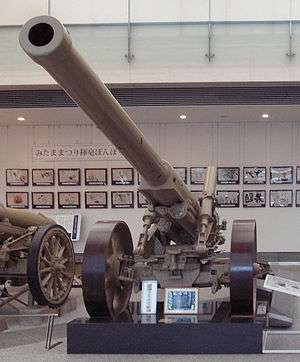Type 89 15 cm Cannon
| Type 89 15 cm Cannon | |
|---|---|
 | |
| Type | Fortress Gun |
| Place of origin | Japan |
| Service history | |
| In service | 1929-1945 |
| Used by | Japan |
| Wars | Sino-Japanese War, World War II |
| Production history | |
| Produced | 1929 |
| Number built | 150 |
| Specifications | |
| Weight |
10,360 kg (22,840 lb) Firing 7,809 kg (17,216 lb) Barrel 7,550 kg (16,645 lb) Cradle Travel |
| Length |
8.03 m (26 ft 4 in) Firing 7.63 m (25 ft 0 in) Barrel 7.29 m (23 ft 11 in) Cradle Traveling |
| Barrel length | 6 m (19 ft 8 in) |
| Width | 1.73 m (5 ft 8 in) Track 2.21 m (7 ft 3 in) Maximum |
| Height | 1.07 m (3 ft 6 in) |
|
| |
| Shell | HE, APHE, Shrapnel, Illumination |
| Caliber | 5.87 in (149 mm) |
| Breech | Interrupted screw |
| Recoil | hydro-pneumatic |
| Carriage | box trail |
| Elevation | -5° to +43° |
| Traverse | 40° |
| Rate of fire | 2 rpm |
| Muzzle velocity | 875 m/s (2,871 ft/s) |
| Maximum firing range | 19,900 m (21,800 yd) |
The Type 89 15 cm Cannon was the main gun of the Imperial Japanese Army heavy artillery units. The Type 89 designation was given to this gun as it was accepted in the year 2589 of the Japanese calendar (1929).[1] It was widely used from the Manchurian Incident to the end of World War II, for example, Nomonhan, Bataan and Corregidor Island, Okinawa. The Type 89 15 cm gun was comparable to the U.S. M1918 155 mm GPF cannon, but the Type 89 has shorter range. The Type 89 was less efficient than similar heavy-caliber guns of other nations in World War II.[1]
Design
The trail was the split-box type trail with detachable spades. The traversing hand wheel and the scale were located on the left side of the carriage. The elevation scale, the range drum, and the sight were on the right side of the carriage.
It fires a shell considerably heavier than that used in the 150 mm howitzer. The Japanese were sufficiently satisfied with this gun to provide it with a fixed mount for siege use in 1930, but as a heavy field piece it has certain definite limitations. Traveling in two loads, it takes longer to emplace than weapons of corresponding caliber in other modern armies and yet it is outranged by all of them.
The Type 89 has a variable hydro-pneumatic recoil system and an interrupted thread breech block; the latter has a mushroom head and stepped-up buttress-type screws. Two carriages have been recovered. The only apparent difference is in the two equilibrators. One has spring type and the other hydrospring type. The trail is the split box type with detachable trail spades. The traversing handwheel and scale are located on the left side of the carriage; the scale is graduated up to 350 mils in ten-mil increments. The elevation scale, range drum, and sight are on the right side of the carriage; the range scale is graduated up to 42 degrees.
An 8-ton prime mover is used to tow the piece. For traveling, the gun is broken down in two loads, tube and carriage.[2]
Combat record
No example of this weapon was captured before 1944, although it was probably used in the Malay and Philippine campaigns.
References
Notes
- 1 2 War Department Special Series No 25 Japanese Field Artillery October 1944
- ↑ 150 mm Gun Type 89" Japanese Artillery Weapons, CINCPAC Bulletin 152, July 1945]
Bibliography
- War Department Special Series No 25 Japanese Field Artillery October 1944
External links
| Wikimedia Commons has media related to Type89 15cm Kanon. |
- "150 mm Gun Type 89" Japanese Artillery Weapons, CINCPAC Bulletin 152, July 1945.